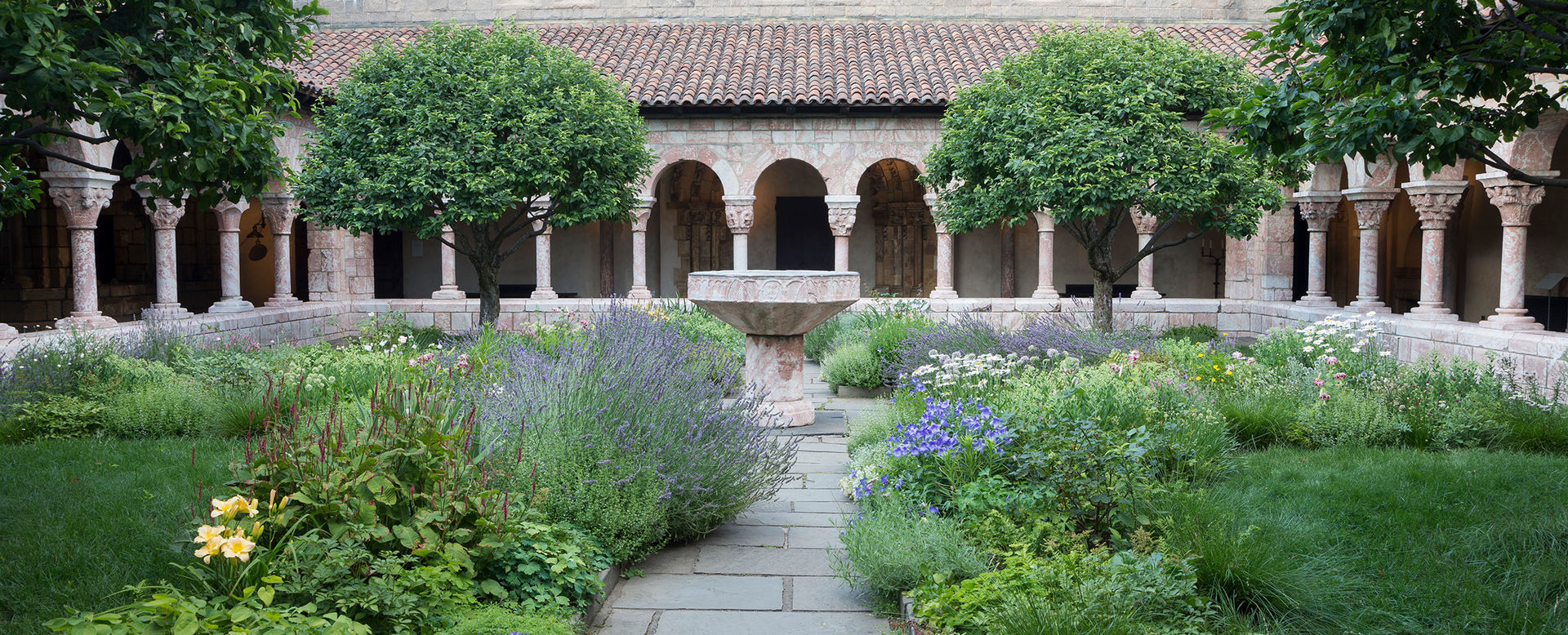
The Gardens of The Met Cloisters
The gardens of the Middle Ages included both real and ideal gardens. Poets and artists delighted in the depiction of fantasy gardens like the Garden of Love or of Paradise, but no real garden of the time remains to us. Historical records are rare and incomplete; the ninth-century plan for the monastery of St. Gall, with its carefully drawn and labeled garden beds, is unique. Archaeological excavations are yielding valuable new evidence, but we still know more about infirmary gardens of medicinal plants and aristocratic pleasure gardens than we do about humble kitchen plots of potherbs and vegetables.
The gardens of the Museum, planted in reconstructed Romanesque and Gothic cloisters, evoke those that provided sustenance and spiritual refreshment within the medieval monastery. Designed as an integral feature of the Museum, the gardens have been a major attraction of The Cloisters since its opening in 1938, enhancing both the setting in which the Museum's collection of medieval art is displayed and the visitor's understanding of medieval life. The gardens are designed and maintained by a horticultural staff actively engaged in researching and developing the living collection.
Download the plant list as a PDF or view each garden's list in the sections below.
The Judy Black Garden in the Cuxa Cloister
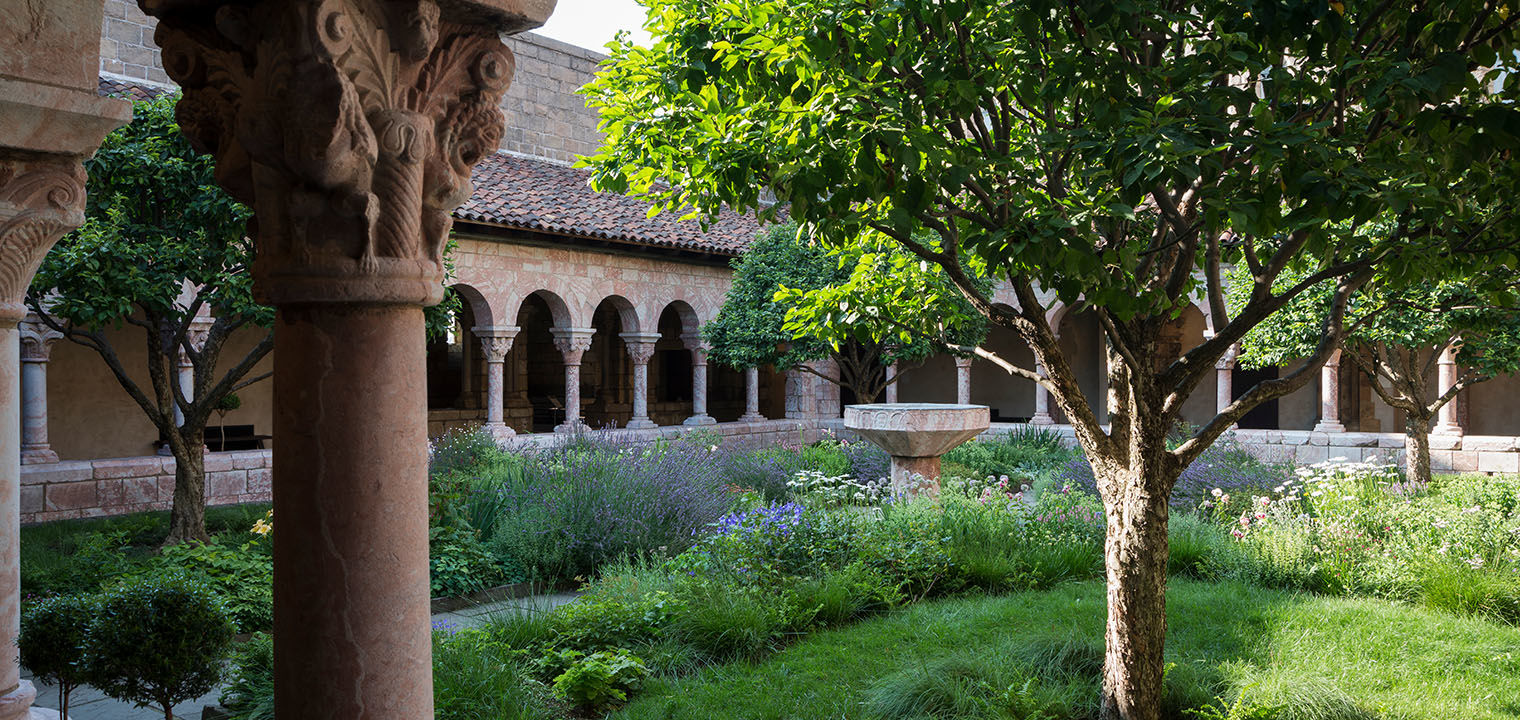
In a monastery, a cloister is a square or rectangular open-air courtyard surrounded by covered passageways. The yard enclosed within these arcades is known as a garth. In a medieval monastic complex, the garth was often situated to the south side of the church, providing a sunny, sheltered place where the monks or nuns could enjoy nature without leaving the monastery.
The plan of the garden is typically medieval. A fountain is set at the center of the crossed paths that divide the garden into quadrants, each with a grass plot and a pollarded crab apple tree. Lawns were often planted in cloister garths, and instructions for planting thick and level lawns were set forth by the Dominican philosopher and scientist Albertus Magnus in the thirteenth century. Herbs and flowers border the paths, although we lack evidence for such plantings in monastic garths. The medieval pleasure garden, with its borders of plants chosen for beauty and fragrance, is the ancestor of our own ornamental gardens. Here medieval European species and modern garden plants from Asia and the Americas have been combined to provide color and scent from early spring until late fall.
In winter, the arcades are glassed in, and the interior walkway becomes a conservatory filled with tender plants such as date palm, orange, rosemary, and bay. Potted bulbs, forced into early bloom, are also on display in late winter and early spring.
Browse Plants in The Judy Black Garden in the Cuxa Cloister for 2025
* Indicates a medieval species or modern ornamental form of a medieval species
Download the plant list as a PDF or view the list in the accordion below.
- Acanthus mollis – Acanthus*
- Achillea millefolium 'Apple Blossom' – Apple Blossom Yarrow*
- Achillea millefolium 'Cerise Queen' — Cerise Queen Yarrow*
- Achillea 'Terracota' — Yarrow*
- Aconitum napellus 'Spark's Variety' — Sparks Variety Monkshood*
- Acorus gramineus – Sweet Flag
- Adiantum venustum — Himalayan Maidenhair Fern
- Adiantum x mairisii 'Mairis' – Maidenhair Fern
- Agastache 'Blue Boa' – Giant Hyssop
- Agastache 'Purple Haze' – Giant Hyssop
- Agastache rugosa 'Little Adder' – Hyssop
- Agrostemma githago 'Rose' — Corncockle*
- Alchemilla mollis — Lady's Mantle*
- Allium 'Millenium' — Millenium Ornamental Onion*
- Allium x lusitanicum 'Summer Beauty' —Ornamental Onion*
- Allium amplectens 'Graceful Beauty' — Narrow Leaf Onion*
- Allium carinatum s. pulchellum — Keeled Garlic*
- Allium senescens 'Medusa' – Ornamental Onion*
- Allium senescens 'Mongolian Gem' – Ornamental Onion*
- Allium senescens subsp montanum — Mountain Garlic*
- Allium thungerbii 'Alba' – White Japanese Allium
- Allium thunbergii 'Ozawa' — Japanese Onion
- Ammi majus 'Graceland' — False Queen Anne's Lace*
- Ammi visnaga 'Casablanca' — Bishop's Weed*
- Anemone x 'Wild Swan' — Windflower
- Anemone x Fantasy 'Jasmine' — Fantasy Jasmine Anemone
- Anemone x 'September Charm' — September Charm Anemone
- Anemone sylvestris — Snowdrop Anemone*
- Anemonopsis macrophylla — False Anemone*
- Aquilegia flabellata 'Nana Alba' — White Columbine*
- Aquilegia 'Heidi' — Columbine
- Armeria maritima 'Dusseldorf Pride' — Sea Thrift*
- Armeria maritima 'Ministicks' — Sea Thrift*
- Armeria maritima 'Rubrifolia' — Sea Thrift*
- Aster dumosus 'Wood’s Pink' — Wood's Pink Aster
- Aster novae-angliae 'Purple Dome' — Purple Dome Aster
- Aster novi-belgii 'Wood’s Pink' — Wood's Pink Aster
- Aster oblongifolius 'October Skies' — October Skies Aster
- Astilbe x arendsii 'Avalanche' — Astilbe
- Astrantia 'Abbey Road' — Masterwort*
- Astrantia 'Burgundy Manor' — Masterwort*
- Astrantia major — Greater Masterwort*
- Athyrium filix-femina 'Lady in Red' — Red Lady Fern*
- Athyrium filix-femina 'Victoriae' — Lady Victoria Fern*
- Athyrium 'Minutissimum' – Lady Fern
- Aurinia saxatilis 'Compacta' – Basket of Gold*
- Baptisia 'Pixie Periwinkle' — Blue False Indigo
- Baptisia australis var. minor — Blue False Indigo
- Begonia grandis — Hardy Begonia
- Bellis perennis — English Daisy*
- Bellis perennis 'Rominette Carmine Rose' — English Daisy*
- Berlandiera lyrata 'Chocolate Drop' – Chocolate Daisy
- Borago officinalis 'Alba' – Borage*
- Bupleurum longifolium 'Bronze Beauty' — Thorow Wax*
- Calamintha nepeta ssp. nepeta — Calamint*
- Calamintha nepeta 'White Cloud' — White Calamint*
- Callistephus chinensis 'Valkyrie Brunhilde Chamois' – China Aster
- Campanula 'Blue Orb' — Bellflower*
- Campanula carpatica 'Blue Clips' — Bellflower*
- Campanula glomerata 'Joan Elliott' — Clustered Bellflower*
- Campanula glomerata 'Caroline' — Clustered Bellflower*
- Campanula poscharskyana — Bellflower*
- Campanula rotundifolia 'Thumbell' — Scottish Bluebell; Harebell*
- Carex caryophyllea 'The Beatles' — Spring Sedge*
- Carex divulsa — Berkeley Sedge*
- Carex flacca 'Blue Zinger' — Blue Sedge*
- Carex oshimensis 'Everdi' — Japanese Sedge
- Centaurea americana 'White' – Basket Flower
- Centaurea americana 'Aloha Rosa' – Basket Flower
- Centaurea cyanus 'Black Gem' – Cornflower*
- Centaurea cyanus 'Jubilee Gem' – Cornflower*
- Centaurea cyanus 'Purple Midget' — Cornflower*
- Cerastium tomentosum 'Snow-In-Summer' — Snow-In-Summer*
- Cerinthe glabra – Honeywort*
- Cerinthe major purpuranscens 'Kiwi Blue' — Honeywort*
- Chrysanthemum 'Sheffield's Pink' – Mum
- Consolida regalis — Larkspur*
- Coreopsis 'Moonbeam' — Tickseed
- Coreopsis verticillata 'Crème Brulee' — Coreopsis
- Cosmo atrosanguineus — Chocolate Cosmo
- Dahlia 'Alloway Candy' – Dahlia
- Daucus carota 'Dara' — Queen Anne's Lace*
- Delphinium 'Magic' – Delphinium
- Deschampsia cespitosa 'Goldtau' — Goldtau Tuffed Hair Grass
- Dianthus 'Bath's Pink' — Cheddar Pink*
- Dianthus barbatus 'Sooty' — Sweet William*
- Dianthus gratianopolitanus 'Firewitch' — Firewitch Dianthus*
- Dianthus plumarius 'Rose de Mai' — Dianthus*
- Dicentra spectabilis 'Valentine' — Bleeding Heart
- Digitalis lantana — Grecian Foxglove*
- Digitalis lutea – Straw Foxglove
- Digitalis purpurea 'Dalmation Purple' — Foxglove*
- Digitalis purpurea 'Pam's Choice' — Foxglove*
- Dryopteris filix-mas 'Parsley' — Parsley Fern*
- Eryngium planum 'Blue Hobbit' — Sea Holly*
- Erysimum cheiri 'Giant Pink' — Pink Wallflower*
- Euphorbia characias subsp. 'Wulfenii' — Spurge*
- Euphorbia myrsinites — Donkeytail Spurge*
- Fagopyrum 'Takane Ruby' – Pink Buckwheat*
- Filipendula 'Elegans' – Meadowsweet
- Filipendula rubra 'Venusta' — Queen of the Prairie*
- Fragaria 'Lipstick' — Strawberry*
- Fragaria moschata — Musk Strawberry*
- Fragaria vesca — Wild Strawberry*
- Foeniculum vulgare 'Purpureum' – Bronze Fennel*
- Galium odoratum* — Sweet Woodruff*
- Gaura lindheimeri 'Belleza Dark Pink' – Gaura
- Gaura lindheimeri 'Whirling Butterflies' — Whirling Butterflies Gaura
- Gentiana andrewsii — Bottle Gentian
- Gentiana x intermedia 'True Blue' – Gentian
- Geranium x 'Orion'* — Cranesbill*
- Geranium 'Rozanne'* — Cranesbill Cultivar*
- Geranium sanguineum 'Album'* — Cranesbill*
- Hemerocallis 'Jane Hayward' — Daylily
- Hylotelephium telephium x spectabile 'Autumn Joy'* — Sedum*
- Iberis 'Purity' – Candytuft
- Iris x germanica — Bearded Iris*
- Iris x germanica 'Feedback' — Bearded Iris*
- Iris pallida – Dalmatian Iris, Sweet Iris*
- Jasione perennis 'Blue Light' — Sheep’s Bit Scabiosa*
- Kalimeris pinnatifida 'Hortensis' — Kalimeris
- Klasea bulgarica — Bulgarian Cornflower
- Knautia macedonica 'Mars Midget' — Knautia
- Lathyrus odoratus 'Cupani' — Sweet Pea*
- Lathyrus odoratus 'Royal Lavender' — Sweet Pea*
- Lavendula x intermedia 'Phenomenal' — Lavandin*
- Lavandula x intermedia 'Provence' — Lavandin*
- Leucanthemum x superbum 'Becky' — Shasta Daisy*
- Liatris spicata 'Floristan Weiss' — White Liatris
- Linum rubrum — Scarlet Flax
- Lobularia maritima 'Carpet of Snow' — Alyssum*
- Matteuccia struthiopteris — Ostrich Fern
- Malus 'Donald Wyman' — Flowering Crab Apple*
- Nepeta x faassenii 'Walker's Low' — Catmint*
- Nepeta racemosa 'Little Titch' — Catmint*
- Oenothera speciosa 'Siskiyou' – Evening Primrose
- Ophiopogon japonicas 'Nana' — Dwarf Mondo Grass
- Origanum rotundifolium 'Kent Beauty' — Kent Beauty Oregano*
- Origanum vulgare — Oregano*
- Orlaya grandiflora — White Lace Flower*
- Papaver 'Royal Wedding' – Poppy
- Papaver somniferum 'Lauren's Grape Poppy' – Poppy*
- Papaver orientalis 'Coral Reef' — Poppy*
- Papaver orientale 'Prinzessin Victoria Louise' – Poppy*
- Perovskia atriplicifolia 'Little Spire' – Russian Sage
- Persicaria amplexicaulis 'Firetail' — Mountain Fleece*
- Physostegia virginiana 'Pink Manners' — Obedient Plant
- Platycodon grandiflorus 'Albus' — Balloon Flower
- Platycodon grandiflorus 'Fuji Blue' — Balloon Flower
- Platycodon grandiflorus 'Mariesii' — Balloon Flower
- Polemonium x 'Heaven Scent' — Jacob’s Ladder*
- Primula veris — Cowslip Primrose*
- Primula vialii — Primrose*
- Rosa 'Heritage' — David Austin English Rose*
- Salvia nemerosa 'Caradonna' – Sage
- Salvia nemerosa 'Rose Marvel' – Sage
- Salvia 'New Dimension Rose' — Sage*
- Salvia officinalis — Sage*
- Sanguisorba 'Burr Blanc' – Great Burnet
- Sanguisorba officinalis 'Chocolate Tip' – Great Burnet
- Santolina chamaecyparissus — Cotton Lavender*
- Scabiosa atropurpurea 'Black Knight' — Pincushion Flower*
- Scabiosa columbaria 'Butterfly Blue' — Pincushion Flower*
- Scabiosa 'Rose Pink' – Pincushion Flower
- Scabiosa stellata 'Starflower' – Pincushion Flower
- Sedum 'Abbeydore' — Sedum*
- Seseli libanotis — Moon Carrot
- Silene coronaria 'Angel Blush' – Rose Campion*
- Silene coronaria ' Oculata' – Rose Campion*
- Silene dioica — Red Catchfly*
- Silene flos-cuculi 'Jenny' – Ragged Robin*
- Silene viscaria 'Snowbird' – Catchfly*
- Silene vulgaris — Bladder Campion*
- Solidago virgaurea – European Goldenrod*
- Stokesia laevis 'Honeysong Purple' — Stokes Aster
- Taraxacum officinale — Dandelion*
- Teucrium canadense — Creeping Germander
- Thalictrum 'Black Stockings' — Meadow Rue*
- Thalictrum rochebrunianum 'Lavender Mistt' — Japanese Meadow Rue*
- Thymus serphyllum 'Magic Carpet' — Thyme*
- Thymus vulgaris 'Compactus' — Thyme*
- Trollius x cultorum 'Cheddar' — Globe Flower
- Trollius europaeus 'Superbus' — Globe Flower
- Verbascum blattaria f. albiflorum – White Blush Mullein*
- Verbascum chaixii 'Album' — Nettle-Leaved Mullein*
- Verbascum phoeniceum 'Antique Rose' – Mullein*
- Verbascum phoeniceum 'Rosetta' — Mullein*
- Verbascum phoeniceum 'Violetta' — Mullein
- Verbena bonariensis 'Purple Top' – Verbana
- Veronica 'Eveline' — Speedwell*
- Veronica 'Pink Moody Blues' – Speedwell
- Veronica x 'Waterperry Blue' — Waterperry Blue Speedwell*
- Veronica commune — Speedwell*
- Veronica incana 'Pure Silver' — Speedwell*
The Bonnefont Cloister Herb Garden
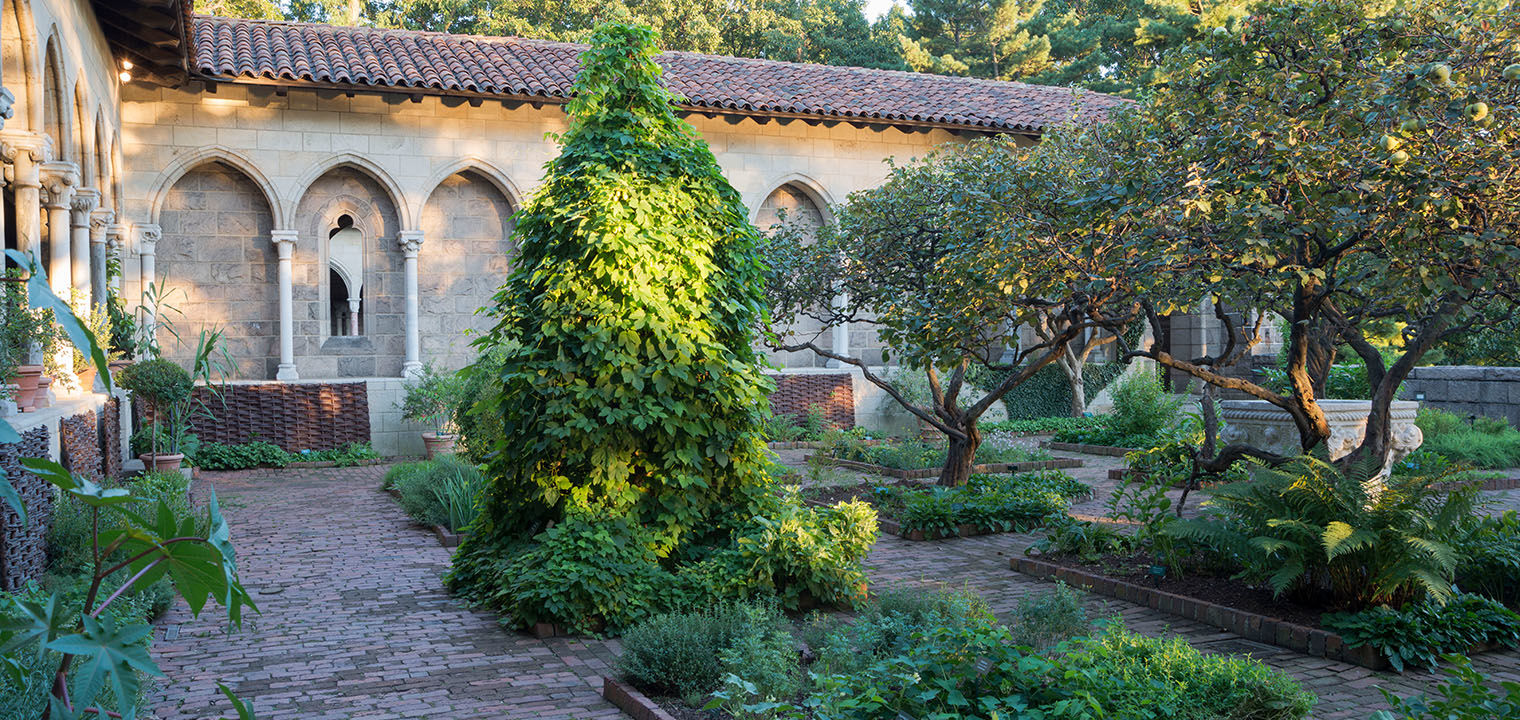
The raised beds of the Bonnefont Cloister Herb Garden hold one of the most specialized plant collections in the world. The foundation of our plant list is a ninth-century edict of the emperor Charlemagne, naming 89 species to be grown on his estates. This list has been supplemented by herbals and monastic records, as well as archaeological evidence. Our collection is based on the more than 400 species of plants known and used in the Middle Ages, not all of which were grown in gardens. Some herbs were gathered from the wild, and exotic spices like black pepper and ginger were imported in dried form.
Plants are grouped and labeled according to their medieval use, whether in cooking, medicine, art, industry, housekeeping, or magic. Most plants had multiple uses, and virtually all plants were believed to have medicinal value. Many herbs, trees, and flowers were used symbolically as well as practically.
Although the plan of the herb garden is typical of a medieval monastic garden, no attempt has been made to replicate that of a particular monastery. The raised beds, wattle fences, and wellhead are all features frequently depicted in medieval sources. Four quince trees—two venerable and two recently-planted specimens—grow in the beds at the center of the garden. Tender plants are grown in terracotta pots that can be moved inside in winter, a common gardening practice in northern Europe throughout the late Middle Ages.
Browse Plants in The Bonnefont Cloister Herb Garden for 2025
* Indicates a plant that is growing but not labeled in the garden bed
Download the plant list as a PDF or view the list in the accordion below.
- Aconitum napellus – Aconite, Monkshood
- Agrimonia eupatoria – Agrimony
- Agrostemma githago — Corn Cockle
- Alcea rosea — Hollyhock
- Ammi visnaga — Tooth-Pick Weed*
- Arctium lappa — Burdock
- Aristolochia clematitis — Birthwort
- Asparagus officinalis — Asparagus
- Bupleurum rotundifolium – Thorow-Wax
- Calendula arvensis — Field Marigold
- Calendula officinalis — Pot Marigold
- Clematis vitalba – Old Man's Beard
- Cnicus benedictus – Blessed Thistle
- Dictamnus albus — White Gasplant
- Digitalis purpurea — Foxglove
- Ecballium elaterium — Squirting Cucumber
- Echium vulgare — Viper's Bugloss
- Erysimum cheiri — Wallflower
- Euphorbia lathyris — Mole Plant, Caper Spurge
- Glaucium flavum — Horned Poppy
- Gypsophila vaccaria – Cow Cockle
- Lactuca virosa – Wild Lettuce
- Lithospermum officinale – Common Gromwell
- Lysimachia arvensis – Scarlet Pimpernel
- Malva sylvestris — Common Mallow, Cheeses
- Mandragora officinarum — Mandrake
- Nigella damascena – Love-in-a-Mist
- Ononis spinosa — Restharrow
- Paeonia officinalis – Peony
- Papaver somniferum — Opium poppy
- Pilosella officinarum — Mouse-Ear Hawkweed
- Prunella vulgaris — Self-Heal
- Rheum officinale — Medicinal Rhubarb
- Ricinus communis – Castor Bean
- Rosa gallica — Apothecary Rose
- Ruta graveolens — Rue
- Salvia officinalis — Common Sage
- Salvia sclarea — Clary
- Salvia viridis — Annual Sage
- Silybum marianum – Milk Thistle
- Staphisagria macrosperma – Stavesacre
- Symphytum officinale — Comfrey
- Tanacetum balsamita — Costmary
- Tanacetum parthenium — Feverfew
- Thymus officinalis — Thyme
- Trigonella foenum-graecum – Fenugreek
- Valeriana officinalis — Common Valerian
- Verbascum thapsus — Common Mullein
- Artemisia abrotanum — Southernwood
- Artemisia absinthium — Absinthe, Wormwood
- Artemisia alba — Camphor Wormwood
- Ballota nigra — Black Horehound
- Chamaemelum nobile – Roman Chamomile
- Filipendula ulmaria — Meadowsweet
- Iris 'Florentina' — Orris, Fleur-de-Lis
- Lavandula angustifolia — English Lavender
- Lilium candidum – Madonna Lily
- Melissa officinalis — Lemon Balm
- Mentha pulegium — Pennyroyal
- Saponaria officinalis — Soapwort
- Silene coronaria — Mullein Pink
- Tanacetum vulgare — Common Tansy
- Allium porrum — Leek
- Allium sativum — Garlic
- Allium schoenoprasum — Chives
- Armoracia rusticana — Horseradish
- Beta vulgaris ssp. maritima — Wild Sea Beet
- Blitum bonus-henricus — Good King Henry
- Borago officinalis — Borage
- Brassica juncea — Black Mustard
- Brassica oleracea — Kale
- Calendula officinalis — Pot Marigold
- Campanula rapunculus — Rampion
- Cichorium intybus — Chicory
- Coriandrum sativum — Coriander
- Crambe martima — Sea Kale
- Cynara cardunculus var. scholymus – Artichoke
- Daucus carota – White Carrot
- Diplotaxis tenuifolia — Wild Rocket
- Eruca sativa — Rocket, Arugula
- Eryngium maritimum — Sea Holly
- Foeniculum vulgare var. azoricum — Florence Fennel
- Inula helenium — Elecampane
- Levisticum officinale — Lovage
- Myrrhis odorata — Sweet Cicely
- Ocimum basilicum — Sweet Basil
- Petroselinum crispum var. neapolitanum — Neapolitan Parsley
- Pisum sativum 'Blue-Podded Capujiner' — Common Pea
- Rumex acetosa — Garden Sorrel
- Rumex scutatus — French Sorrel
- Sanguisorba major — Great Burnet
- Sanguisorba minor — Salad Burnet
- Sium sisarum — Skirret
- Taraxacum officinale — Dandelion
- Thymus serpyllum — Creeping thyme
- Valeriana rubra — Red Valerian
- Vicia faba 'Martock' — Broad Bean
- Fagopyrum esculentum – Buckwheat
- Lagenaria siceraria – Bottle Gourd
- Secale cereale — Rye
- Achillea millefolium — Common Yarrow
- Achillea ptarmica — Sneezewort
- Aconitum napellus — Monkshood
- Alchemilla vulgari — Lady's Mantle
- Artemisia vulgaris — Mugwort
- Arum italicum — Italian Arum
- Atropa belladonna — Belladonna
- Betonica officinalis – Betony
- Bistorta officinalis –Bistort
- Carlina acaulis — Stemless Carline Thistle
- Carlina vulgaris – Carline Thistle
- Catananche caerulea — Cupid's Dart
- Colchicum autumnale — Autumn Crocus
- Cota sancti-johannis — St. John's Chamomile
- Cynoglossum officinale — Hounds Tongue
- Datura metel — Downy Thorn Apple
- Delphinium consolida — Larkspur
- Doronicum pardalianches — Great Leopard's Bane
- Dracunculus vulgaris — Dragon Arum
- Foeniculum vulgare — Fennel
- Fumaria officinalis — Fumitory
- Geum urbanum — Herb Bennet
- Hyoscyamus niger — Henbane
- Hypericum perforatum — St. John's Wort
- Leonurus cardiaca — Motherwort
- Leucanthemum vulgare — Ox-Eye Daisy
- Lysimachia arvensis — Scarlet Pimpernel
- Mandragora autumnalis — Autumn Mandrake
- Mandragora officinarum — Mandrake
- Paeonia officinalis – Peony
- Papaver dubium — Long-Headed Poppy
- Papaver rhoeas — Corn Poppy
- Plantago lanceolata — Ribgrass Plantain
- Plantago major — Common Plantain
- Plantago media — Hoary Plantain
- Salvia glutinosa — Jupiter's Distaff
- Sempervivum tectorum — Houseleek
- Solanum dulcamara — Woody Nightshade
- Verbascum thapsus — Mullein
- Verbena officinalis — Vervain
- Colchicum autumnale — Autumn Crocus
- Cornus mas — Cornelian Cherry
- Dracunculus vulgaris — Dragon Arum
- Fragaria vesca — Wild Strawberry
- Hedera helix — English Ivy
Shade Bed I
- Anthericum liliago — St. Bernard's Lily
- Dryopteris filix-mas –Male Fern*
- Myosotis scorpioides – Forget-me-not
- Lilium candidum – Madonna Lily
- Viola odorata — Sweet Violet
- Vitex agnus-castus – Chaste Tree
Shade Bed II
- Rubus ulmifolius — Blackberry
- Aquilegia vulgaris — Columbine
- Fragaria vesca — Wild Strawberry
- Hyacinthoides non-scripta — English Bluebell
- Lilium candidum — Madonna Lily
- Rosa alba 'Semi-plena' — White Rose
- Viola odorata — Sweet Violet
- Viola tricolor — Heart's Ease
- Acanthus spinosus — Spiny Acanthus
- Arum italicum — Italian Arum
- Arum maculatum – Cuckoopint, Lords-and-Ladies
- Ficus carica — Fig Tree
- Filipendula vulgaris — Dropwort
- Geum rivale — Water Avens
- Polygonatum odoratum — Solomon's Seal
- Symphytum officinale — Comfrey*
- Thalictrum aquilegifolium — Meadow Rue*
- Agrimonia eupatoria – Agrimony
- Anchusa officinalis — Alkanet
- Anthemis tinctoria — Golden Marguerite
- Carthamus tinctorius — Safflower
- Chelidonium majus — Greater Celandine
- Crocus sativus (dormant) — Saffron Crocus
- Dipsacus sativus — Teasel
- Equisetum hyemale — Horsetail
- Galium verum — Our Lady's Bedstraw
- Genista tinctoria – Dyer's Greenweed
- Gossypium herbaceum — Levant Cotton
- Indigofera tinctoria — Indigo
- Iris x germanica — Flag, Fleur de Lis
- Iris pseudoacorus — Yellow Flag
- Isatis tinctoria — Woad
- Linum usitatissimum — Flax
- Onopordum acanthium — Cotton Thistle
- Reseda luteola — Weld
- Rubia tinctorium — Madder
- Urtica dioica — Stinging Nettle
- Humulus lupulus — Hops
- Tanacetum balsamita — Costmary, Alecost
- Alyssum wulfenianium — Madwort*
- Arenaria montana — Sandwort*
- Armeria maritima — Sea Thrift
- Artemisia dracunculus — Tarragon
- Buxus sempervirens — Boxwood Topiary
- Calamintha officinalis — Calamint
- Calendula officinalis — Pot Marigold
- Crithmum maritimum — Samphire
- Crocus sativus — Saffron Crocus
- Dianthus superbus — Fringed Pink
- Digitalis purpurea – Foxglove
- Dracocephalum officinale – Hyssop
- Glycyrrhiza glabra — Licorice
- Gratiola officinalis — Hedge Hyssop
- Lavandula officinalis — Lavender
- Lilium candidum –Madonna Lily
- Nepeta cataria — Catnip
- Origanum marjorana — Marjoram
- Origanum vulgare — Oregano
- Rosa gallica – Apothecary Rose
- Salvia officinalis — Common Sage
- Satureja montana — Winter Savory
- Thymus serpyllum — Creeping Thyme
- Thymus vulgaris — Common Thyme
- Viola tricolor — Heart's Ease
- Anethum graveolens – Dill
- Mentha x piperita — Peppermint
- Pyrus communis — Common Pear
- Thymus serpyllum — Creeping Thyme
- Ajuga reptans — Bugle
- Angelica archangelica – Garden Angelica
- Aquilegia vulgaris — Columbine
- Asarum europaeum — European Wild Ginger
- Betonica officinalis – Betony
- Chamaemelum nobile — Roman Chamomile
- Chelidonium majus — Greater Celandine
- Convallaria majalis — Lily of the Valley
- Cydonia oblonga — Quince
- Dryopteris filix-mas — Male Fern
- Galium odoratum — Sweet Woodruff
- Geranium robertianum — Herb Robert
- Helleborus niger — Christmas Rose
- Helleborus orientalis — Lenten Rose
- Lathyrus tuberosus – Earth-nut Pea
- Myrrhis odorata — Sweet Cicely
- Osmunda regalis — Royal Fern
- Paris quadrifolia — Herb Paris
- Polygonatum odoratum –Solomon's Seal
- Primula veris — Cowslip
- Pulmonaria officinalis — Lungwort
- Pulsatilla vulgaris – Pasque Flower
- Silene latifolia — White Campion
- Tanacetum parthenium — Feverfew
- Teucrium scorodonia – Wood Sage
- Viola odorata — Sweet Violet
- Viola tricolor — Heart's Ease
- Acanthus mollis — Acanthus
- Adiantum capillis-veneris — Maiden hair fern
- Aloe vera — Medicinal Aloe
- Arbutus unedo — Strawberry Tree
- Boswellia carteri — Frankincense
- Buxus sempervirens — Boxwood
- Ceratonia silique — Carob
- Chamaerops humilis — European Fan Palm
- Cistus ladanifer — Common Gum Cistus
- Citrus x aurantium var. myrtifolia "Chinotto" — Sour Orange
- Commiphora africana — False Myrrh
- Cyclamen purpurascens — Cyclamen
- Dianthus carthusianorum — Clusterhead Pink
- Dianthus caryophyllus — Clove Pink
- Dianthus deltoides – Maiden Pink
- Equisetum hyemale — Rough Horsetail
- Hedera helix — English Ivy
- Jasminum officinale f. affine — Large-Flowered Jasmine
- Laurus nobilis — Bay Laurel
- Lawsonia inermis – Henna
- Myrtus communis — Myrtle
- Myrtus communis ssp. tarentina — Tarentum myrtle
- Nasturtium officinale – Common Watercress
- Nerium oleander — Common Oleander
- Olea europaea — Common Olive
- Origanum dictamnus — Dittany of Crete
- Phoenix dactylifera — Date Palm
- Punica granatum — Pomegranate
- Ricinus communis — Castor Bean
- Ruscus aculeatus — Butcher’s Broom
- Rosmarinus officinalis — Rosemary
- Santolina chamaecyparissus — Cotton Lavender
- Sempervivum tectorum — Houseleek
- Alpinia officinarum — Lesser galangal
- Cinnamomum verum — True Cinnamon
- Curcuma longa — Turmeric
- Elettaria cardamomum — Cardamom
- Piper nigrum — Common pepper
- Zingiber officinale — Common Ginger
The Trie Cloister Garden
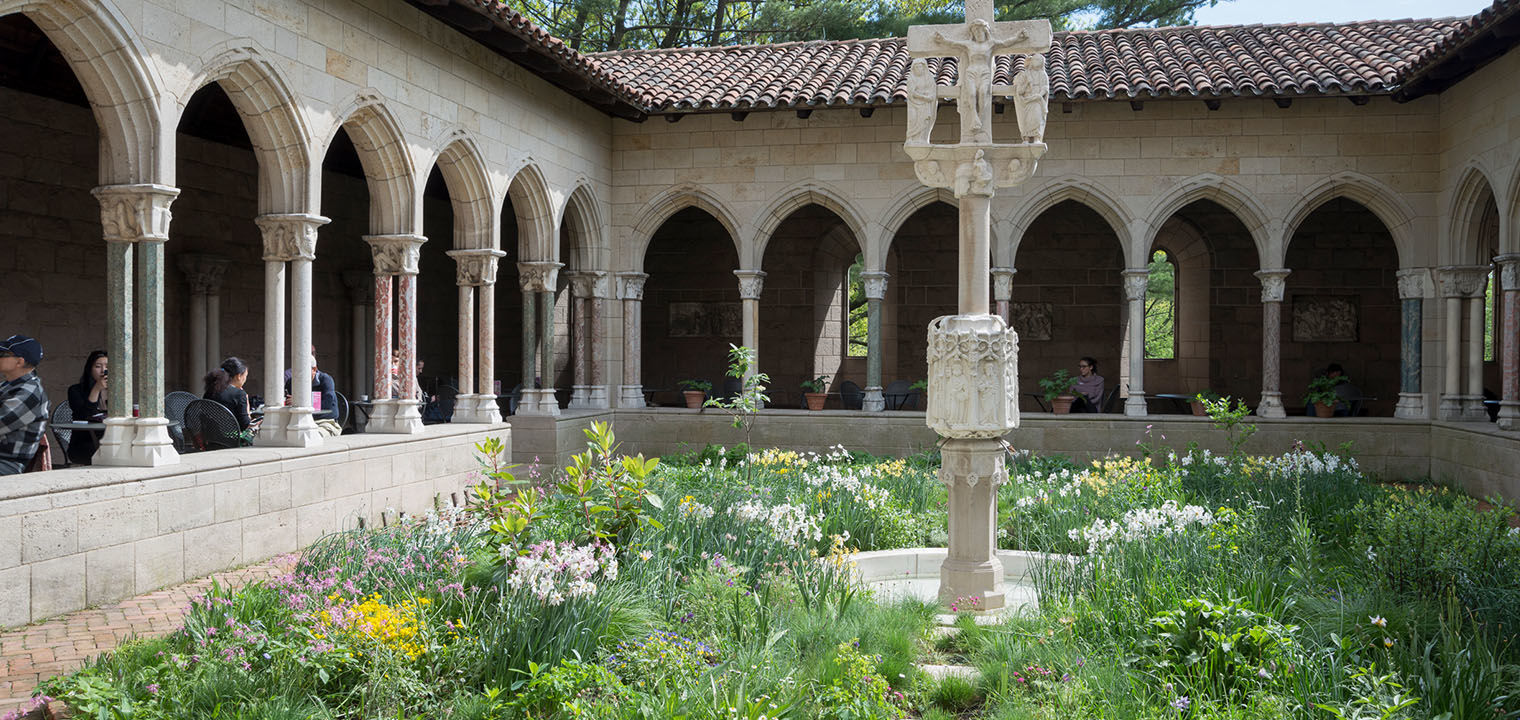
The Trie Cloister Garden evokes the idealized gardens and landscapes of the Middle Ages. The joy the medieval world felt upon the return of spring was expressed in their verdant, millefleur tapestries, allegorical poems, and paintings. The garden's plantings are inspired by that cherished medieval setting, the enameled mead or flowering meadow.
While medieval apothecary and vegetable gardens were orderly, with pleasing symmetry and balance, the medieval fantasy garden was a place of unbridled and untamed nature. This ecstatic vision of nature is evident in the Unicorn Tapestries' myriad of flowers and fruits. Regardless of their natural cycles: fall fruits, winter berries, and spring flowers coexist in a vision of an eternal spring. Much of the flora found blooming in the tapestries is cultivated here, though the plants bloom in their proper seasons.
Browse Plants in The Trie Cloister Garden for 2025
* Indicates a plant identified in The Unicorn Tapestries
Download the plant list as a PDF or view the list in the accordion below.
- Acanthus spinosus — Bear’s Breeches
- Aconitum lycotonum – Wolfsbane
- Aconitum napellus — Monkshood
- Acorus calamus — Sweet Flag
- Adenophora liliifolia — Ladybells
- Adonis aestivalis — Pheasant’s Eye*
- Alchemilla vulgaris — Lady’s Mantle*
- Allium nutans — Ornamental Onion
- Allium schoenoprasum — Chives
- Allium senescens ssp. glaucum – Curly Onion
- Allium senescens 'Medusa' – Ornamental Onion
- Ammi visnaga 'Casablanca' – Toothpick Weed
- Anagallis arvensis — Pimpernel*
- Anemone nemorosa — Wood Anemone
- Anemone sylvestris – Windflower
- Angelica archangelica — Garden Angelica
- Anthericum ramosum – St. Bernard's Lily
- Anthriscus sylvestris 'Ravenswing' – Cow Parsley
- Antirrhinum majus –Snapdragon
- Aquilegia alpina — Alpine Columbine
- Aquilegia vulgaris — Columbine*
- Arenaria montana — Sandwort
- Armeria juniperifolia — Pink Dwarf Armeria
- Armeria maritima — Sea Thrift
- Arum maculatum — Cuckoopint*
- Asarum europaeum — European Ginger
- Asphodeline lutea — Yellow Asphodel
- Asphodelus albus – Asphodel
- Asplenium scolopendrium — Hart's Tongue Fern*
- Aster alpinus — Alpine Aster
- Aster amellus — Michaelmas-Daisy
- Athyrium filix-femina — Lady Fern
- Aurinia saxatilis — Basket-of-Gold
- Bellis perennis — English Daisy*
- Borago officinalis – Borage
- Briza media – Quaking Grass
- Buphthalmum salicifolium — Ox-Eye
- Calamintha nepeta — Lesser Calamint
- Caltha palustris — Marsh Marigold
- Campanula alliariifolia — Cornish Bellflower
- Campanula bellidifolia — Caucasian Bellflower
- Campanula carpatica forma alba — Carpathian Bellflower
- Campanula cochleariifolia — Earleaf Bellflower
- Campanula glomerata var. alba — Clustered Bellflower
- Campanula latifolia var. macrantha 'alba' — Bellflower
- Campanula linifolia — Flax Bellflower
- Campanula poscharskyana — Siberian Bellflower
- Campanula rotundifolia — Scottish Bellflower
- Calendula officinalis— Pot Marigold*
- Carex divulsa — Berkeley Sedge
- Carthamus tinctorius — Safflower*
- Centaurea cyanus — Cornflower*
- Centaurea erythraea — Common Centaury
- Centaurea montana — Mountain Cornflower
- Centaurea macrocephala –Knapweed
- Centaurea nigra –Lesser Knapweed
- Centaurea scabiosa — Greater Knapweed
- Centranthus ruber — Red Valerian
- Cephalaria gigantea – Giant Pincushion
- Cerastium tomentosum — Snow-In-Summer
- Cerinthe major purpurascens 'Kiwi Blue' – Honeywort
- Cerinthe major – Honeywort
- Chamaemelum nobile — Chamomile
- Cheiranthus cheiri — Wallflower*
- Chrysanthemum segetum — Corn Marigold*
- Cortusa matthioli – Alpine Bells
- Crataegus monogna 'Compacta' – Hawthorn
- Crepis rubra — Hawksbeard*
- Cyclamen coum – Cyclamen
- Cyclamen hederifolium – Ivy-leaved Cyclamen
- Cymbalaria pallida — Italian Toadflax
- Dianthus arenarius — Sand Pink
- Dianthus carthusianorum — Carthusian Pink
- Dianthus caryophyllus — Carnation*
- Dianthus cruentus — Blood Pink
- Dianthus deltoides — Maiden Pink
- Dianthus gratianopolitanus — Cheddar Pink
- Dianthus knappii — Sulphur Pink
- Dianthus neglectus/pavonius — Peacock-eye Pink
- Dianthus pinifolius — Pineleaf Garden Pink
- Dianthus pontederae — Divine Pink
- Dianthus simulans — Alpine Pink
- Dianthus subacaulis — Border Pink
- Dianthus superbus — Fringed Pink*
- Dianthus sylvestris — Woodland Pink
- Digitalis purpurea — Foxglove
- Echium vulgare –Viper's Bugloss
- Edraianthus graminifolius — Grassy Bells
- Epilobium dodonaei – Willowherb
- Euphorbia cyparissias — Cypress Spurge
- Euphorbia myrsinites — Myrtle Spurge
- Euphorbia palustris – Swamp Spurge
- Festuca ovina — Sheep's Fescue
- Festuca tenuifolia — Angel Hair Fescue
- Fragaria vesca — Woodland Strawberry*
- Galium odoratum — Sweet Woodruff
- Globularia punctata – Ball Flower
- Helianthemum nummularium –Rock Rose
- Helleborus niger – Christmas Rose
- Helleborus orientalis — Lenten Rose
- Hesperis matronalis — Dame's Rocket*
- Hyssopus officinalis — Hyssop
- Inula ensifolia — Elecampane
- Inula helenium — Elecampane
- Iris x germanica — Fleur de Lis*
- Jasione perennis – Sheep's Bit*
- Juncus effusus — Rush
- Klasea bulgarica –Bulgarian Cornflower
- Lathyrus latifolius – Everlasting Pea
- Lavandula angustifolia — Lavender
- Leontopodium nivale — Edelweiss
- Leucanthemella serotina — Autumn Ox-Eye Daisy
- Leucanthemum vulgare — Ox-Eye Daisy*
- Lilium candidum — Madonna Lily*
- Limonium latifolium — Sea Lavender
- Linara vulgaris – Yellow Toadflax
- Lunaria annua – Annual Honesty
- Lunaria biennis — Honesty*
- Malva sylvestris 'Zebrina' – Zelba
- Matthiola incana — Stock*
- Myosotis sylvatica — Forget-Me-Not*
- Nigella arvensis — Field Fennel*
- Origanum dictamnus — Dittany of Crete
- Origanum vulgare — Wild Marjoram
- Orlaya grandiflora – Lace Flower
- Osmunda regalis – Royal Fern
- Paeonia officinalis — Peony
- Papaver alpinum – Alpine Poppy
- Papaver rhoeas — Corn Poppy
- Phyteuma betonicifolium — Betony-Leaved Rampion*
- Phyteuma scheuchzeri — Horned Rampion*
- Plantago lanceolata — Narrowleaf Plantain
- Plantago major — Greater Plantain
- Plantago media — Hoary Plantain
- Polemonium caeruleum — Jacob's Ladder
- Polygonatum odoratum — Solomon's Seal
- Primula auricula — Primrose
- Primula veris — Cowslip*
- Primula vulgaris — Primrose*
- Pulmonaria officinalis — Lungwort
- Pulsatilla vulgaris — Pasque Flower
- Rosa damascena 'Belladonna'–Damask Rose
- Salvia officinalis — Sage*
- Salvia sclarea — Clary Sage*
- Santolina chamaecyparissus — Santolina
- Scabiosa columbaria f. nana — Little Pincushion
- Scabiosa graminifolia – Scabious
- Senecio doronicum –Leopard's-bane*
- Silene chalcedonica –Maltese Cross
- Silene coronaria 'Alba' – White Campion
- Silene coronaria – Rose Campion
- Silene flos-cuculi – Ragged Robin
- Silybum marianum –Milk Thistle*
- Soldanella alpina – Alpine Snowbell
- Solidago virgaurea — European Goldenrod
- Solidago virgaurea ssp. minuta — European Goldenrod
- Tanacetum parthenium –Feverfew*
- Taraxacum offincinale — Dandelion*
- Thalictrum aquilegifolium –Meadow Rue
- Thalictrum lucidum — Shining Meadow Rue
- Thymus praecox — Wild Thyme
- Thymus richardii — Thyme
- Thymus serpyllum — Creeping Thyme
- Verbascum chaixii — Narrow-Leaved Mullein
- Verbascum phoeniceum — Mullein
- Verbascum nigrum — Black Mullein
- Vinca minor — Vinca*
- Viola cornuta 'Purple Showers' — Tufted Violet
- Viola jooi — Transylvanian Violet
- Viola odorata — Sweet Violet*
- Viola tricolor — Heart's Ease*
The Orchard
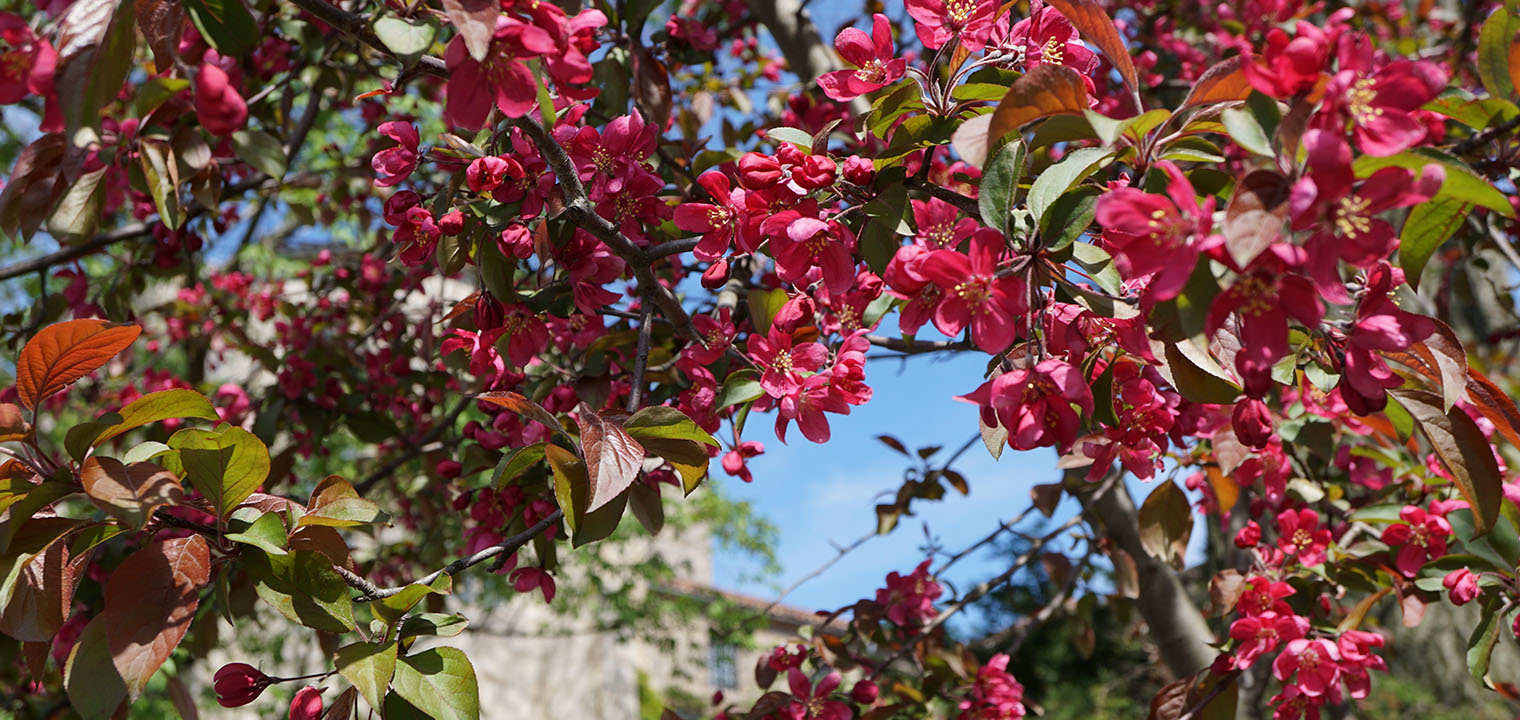
From the south wall of Bonnefont Garden, is an orchard of lady apples and other medieval fruits such as medlar, quince, currants, and elderberries. Orchards were associated with monasteries, manor houses, and parks, and were often enclosed to keep out thieves. A willow hedge separates the orchard precinct from the Museum lawn and the park beyond it. The ground under the fruit trees is planted to evoke the flowering meadow that was a common feature of medieval pleasure grounds.
The Cloisters' orchard meadow is stocked with spring bulbs that naturalize and form large colonies over time. A variety of herbs and flowers reseed themselves each year, and are cut back to the ground in late summer.
Orchard photography by Marc Montefusco; all other photography by John M. Hall.
Visit The Met Cloisters
See information about visiting The Met Cloisters, including directions, admission prices, and dining options.




